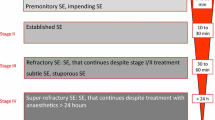Opinion statement
-
The clinical syndrome of nerve agent toxicity varies widely, ranging from the classic cholinergic syndrome to flaccid paralysis and status epilepticus.
-
All nerve agents are capable of producing marked neuropathology. Seizure control is strongly associated with protection against acute lethality and brain pathology.
-
The mainstays of therapy of nerve agent poisoned patients are atropine, pralidoxime, and benzodiazepines.
-
Fosphenytoin provides little therapeutic anticonvulsant effectiveness for nerve agent-induced status epilepticus.
-
Tachycardia is not a contraindication to treatment with atropine in nerve agent toxicity.
-
Atropine should be administered to alleviate respiratory distress, symptomatic bradycardia, and as an adjunct to benzodiazepines and pralidoxime to alleviate seizure activity.
-
In significant nerve agent toxicity, a continuous pralidoxime infusion may be considered.
Similar content being viewed by others
References and Recommended Reading
Holstege CP, Kirk M, Sidell FR: Chemical warfare. Nerve agent poisoning. Crit Care Clin 1997, 13:923–942.
Shih TM, Duniho SM, McDonough JH: Control of nerve agent-induced seizures is critical for neuroprotection and survival. Toxicol Appl Pharmacol 2003, 188:69–80. This study showed that all nerve agents were capable of producing neuropathology. Seizure control was strongly associated with protection against acute lethality and brain pathology.
Tuovinen K: Organophosphate-induced convulsions and prevention of neuropathological damages. Toxicology 2003, 196:31–39. This study showed that atropine in combination with diazepam and pralidoxime reduced the toxicity of nerve agents.
Shih TM, McDonough JH: Organophosphorus nerve agents-induced seizures and efficacy of atropine sulfate as anticonvulsant treatment. Pharmacol Biochem Behav 1999, 64:147–153.
Shih TM, McDonough JH: Efficacy of biperiden and atropine as anticonvulsant treatment for organophosphorus nerve agent intoxication. Arch Toxicol 2000, 74:165–172. This study shows that all nerve agents can produce status epilepticus. It also showed that atropine is capable of stopping these epileptiform seizures induced by nerve agents.
Kozak RJ, Siegel S, Kuzma J: Rapid atropine synthesis for the treatment of massive nerve agent exposure. Ann Emerg Med 2003, 41:685–688.
Medicis JJ, Stork CM, Howland MA, et al.: Pharmacokinetics following a loading plus a continuous infusion of pralidoxime compared with the traditional short infusion regimen in human volunteers. J Toxicol Clin Toxicol 1996, 34:289–295. This study indicates that a loading dose followed by a continuous infusion of pralidoxime maintains therapeutic concentrations for a longer period of time than the historically recommended intermittent bolus infusion method.
Schexnayder S, James LP, Kearns GL, et al.: The pharmacokinetics of continuous infusion pralidoxime in children with organophosphate poisoning. J Toxicol Clin Toxicol 1998, 36:549–555. This study recommends a loading dose of 25 to 50 mg/kg of pralidoxime followed by a continuous infusion of 10 to 20 mg/kg/hr in children.
Sakurda K, Matsubara K, Shimizu K, et al.: Pralidoxime iodide (2-PAM) penetrates across the blood-brain barrier. Neurochem Res 2003, 28:1401–1407. This study indicated that administration of pralidoxime may be effective at reactivating brain cholinesterase blocked by nerve agents.
Shih TM, McDonough JH, Koplovitz I: Anticonvulsants for Soman-Induced Seizure Activity. J Biomed Sci 1999, 6:86–96. This study showed that diazepam could block soman-induced seizure activity and could terminate soman-induced seizure activity if diazepam was given early after seizure onset.
McDonough JH, Zoeffell LD, McMonagle J, et al.: Anticonvulsant treatment of nerve agent seizures: anticholinergics versus diazepam in soman-intoxicated guinea pigs. Epilepsy Res 2000, 38:1–14.
McDonough JH, McMonagle J, Copeland, et al.: Comparative evaluation of benzodiazepines for control of soman-induced seizures. Arch Toxicol 1999, 73:473–478. This study showed that all benzodiazepines were effective in stopping nerve agent-induced seizures. There were marked differences between benzodiazepines in the rapidity of seizure control. Midazolam was the most potent and rapidly acting benzodiazepine.
McDonough JH, Benjamin A, McMonagle JD, et al.: Effects of fosphenytoin on nerve-agent-induced status epilepticus. Drug Chem Toxicol 2004, 27:27–39. This study showed that fosphenytoin, either alone or in combination with diazepam, has little or no therapeutic anticonvulsant effectiveness for nerve agent-induced status epilepticus.
Capacio BR, Byers CE, Merk KA, et al.: Pharmacokinetic studies of intramuscular midazolam in guinea pigs challenged with soman. Drug Chem Toxicol 2004, 27:95–110. This study suggested that intramuscular applied midazolam was effective in terminating ongoing nerve-agent induced seizure activity.
Gilat E, Goldman M, Lahat E, et al.: Nasal midazolam as a novel anticonvulsive treatment against organophosphate-induced seizure activity in the guinea pig. Arch Toxicol 2003, 77:167–172. This study showed that nasal midazolam could be used as a novel, rapid, and convenient route of application against seizure activity induced by nerve agent poisoning.
Rotenberg JS, Newmark MD: Nerve agent attacks on children: diagnosis and management. Pediatrics 2003, 112:648–658.
Lifshitz M, Shahak E, Sofer S: Carbamate and organophosphate poisoning in young children. Pediatr Emerg Care 1999, 15:102–103.
Author information
Authors and Affiliations
Rights and permissions
About this article
Cite this article
Holstege, C.P., Dobmeier, S.G. Nerve agent toxicity and treatment. Curr Treat Options Neurol 7, 91–98 (2005). https://doi.org/10.1007/s11940-005-0018-y
Issue Date:
DOI: https://doi.org/10.1007/s11940-005-0018-y




